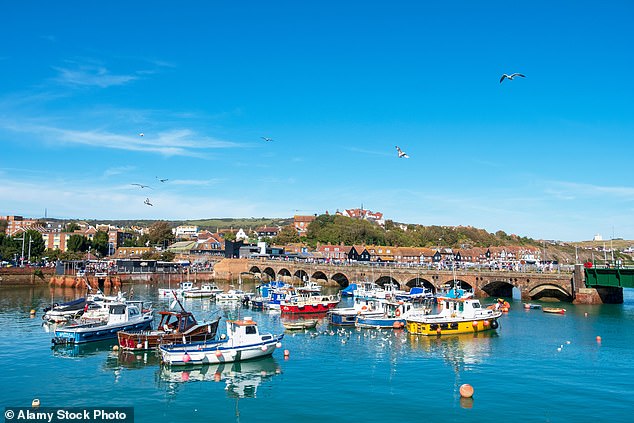<!–
<!–
<!– <!–
<!–
<!–
<!–
Every year around this time we hear of plans to regenerate decaying seaside towns and dreary resorts, from Margate to Morecambe.
However, none could match the dramatic transformation of Folkestone on the south coast of Kent.
Just ten years ago, Folkestone was falling. “I moved here in 2015 from Gran Canaria to work in a hotel and some parts of the city, especially the port area, were scary, so I moved to Canterbury,” says Alex Rodríguez, 31, who now works as freelance in corporate communications.

Turning the tide: Harbor once off-limits to coastal Kent town now hot spot
“Then I heard about the changes that were happening, so in 2020 I moved back here with my husband and bought a three-bedroom Victorian house with a terrace for £240,000.
I have never regretted it. Today, Folkestone has a really great atmosphere and beautiful countryside.”
It’s hard to imagine the Folkestone Alex found in 2015. Much of the harbor and seafront was taken up by railway sidings, a seedy fairground and a flea market. The old town area was, to put it bluntly, a poor neighborhood.
It took Sir Roger De Haan’s ambition to create the Folkestone of today. He bought the town’s harbor in 2004 with a view to regenerating it.
“My parents founded Saga (the travel company) and when I sold the company in 2004 (for £1.35bn) I was still in my early 50s and needed to keep working,” Sir Roger told me. “I decided on four lines of regeneration: education, buildings, arts and sport.”
These areas desperately needed attention. Folkestone had one of the five least academically successful secondary schools in England.
Investing £34 million, Sir Roger had architect Norman Foster design a replacement and it is now judged “good” by Ofsted.
Sir Roger also helped set up performance venues and invested money in a variety of sporting facilities.
But the flagship of the renovated Folkestone is a development of 84 seafront apartments. Located on pebbles high above the beach, it is built of bright white glazed bricks.
The large balconies give the outside a Gaudi-style look, while inside the curvature of the tall windows makes the rooms bathed in light. Wood and pebble materials echo the coastal theme.
Prices range from £430,000 for a one-bedroom apartment to £2.2 million for a penthouse. Six more blocks are planned, with a total of 1,000 units (shorelinefolkestone.co.uk).
Nearby is the restored Harbor Arm, with its champagne bar and food stalls. Stroll south along the boardwalk and you’ll pass brightly painted beach huts and a landscaped coastal path.
The renovated Old High Street is now packed with independent shops and studios, not unlike the popular, chi-chi Whitstable on the north Kent coast.
“It has a really cosmopolitan atmosphere,” says Alex. “There are a lot of freelancers and we meet in a café twice a week, which creates a real sense of community.”
There is plenty to attract newcomers, as London’s St Pancras is just an hour away. So, with so many coastal cities looking to reinvent themselves, what is the secret to successful regeneration?
“In areas where the economy is broken, it is not enough to fix the buildings,” said Sir Roger. “The city has to be given a completely new economic purpose… there has to be a big global ambition.”

